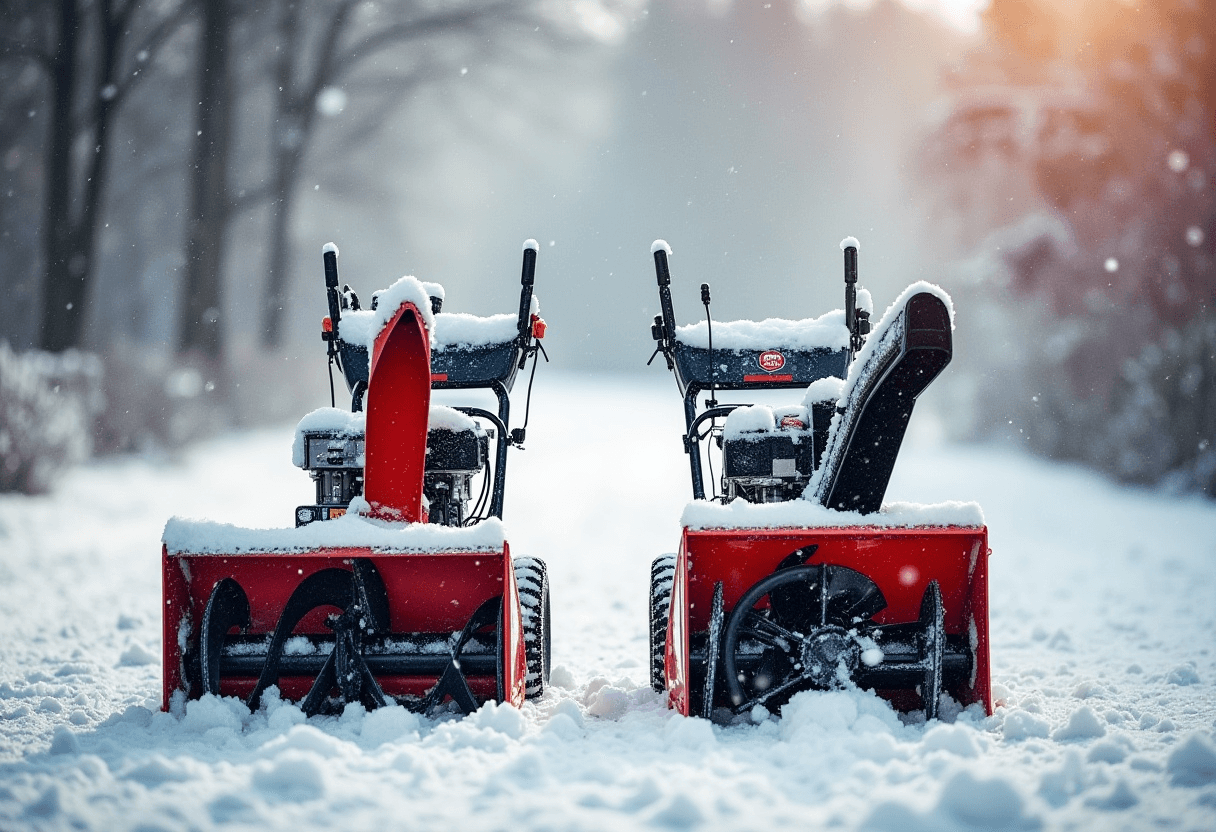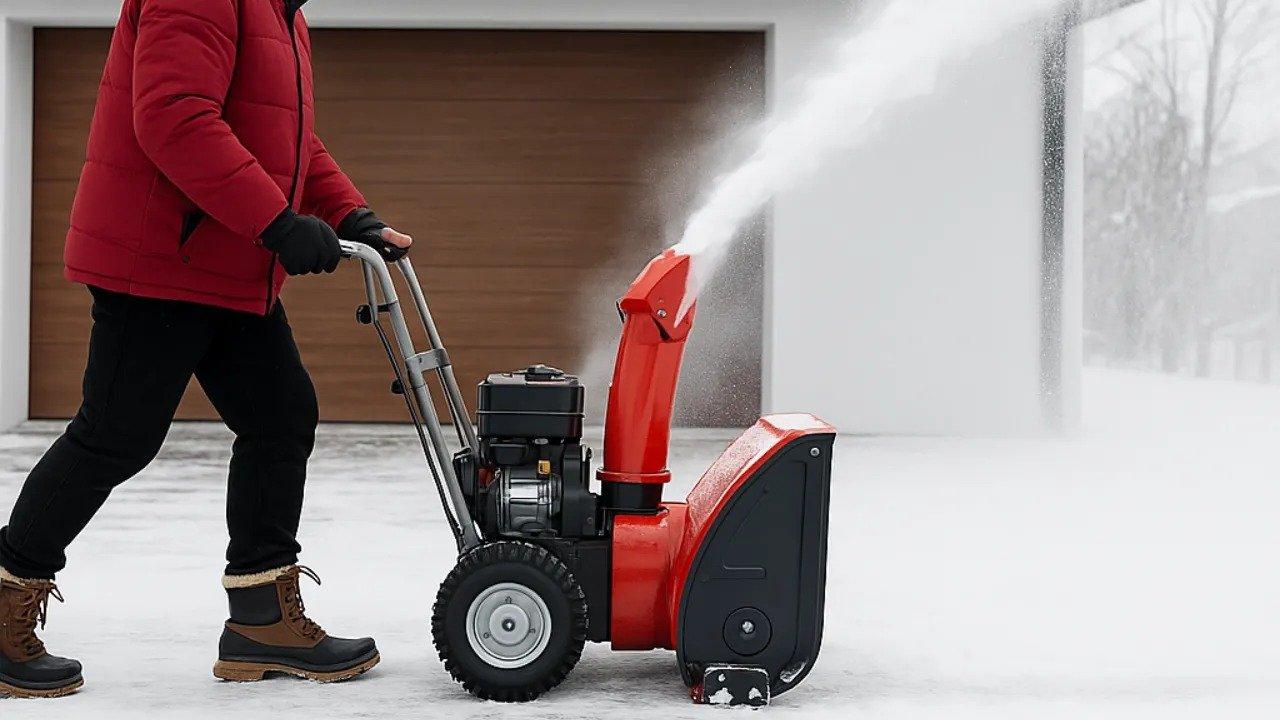Review
Single-Stage vs Two-Stage Snow Blowers: What’s the Difference?
AZparts Team
Updated on November 1, 2025
8 min read
Winter brings the challenge of snow removal for many homeowners and property managers. Choosing between a single-stage and two-stage snow blower significantly impacts your snow-clearing efficiency and experience. In this comprehensive guide, AZParts explores the key differences between these two types of snow blowers, helping you make an informed decision based on your specific needs.

1. Difference Between Single-Stage and Two-Stage Snow Blower
Difference between single-stage and two-stage snow blower (Source: Google)
When shopping for a snow blower, understanding the fundamental differences between single-stage and two-stage models is crucial for making the right investment. These machines differ in design, functionality, performance, and price points - each optimized for different snow conditions and property types.
Feature | Single-Stage Snow Blower | Two-Stage Snow Blower |
Auger and Impeller System | • Single rubber-edged auger performs dual functions: collecting and throwing snow • Direct ground contact • Fewer moving parts • Ideal for completely paved surfaces | • More sophisticated system with dedicated components • Metal auger breaks up and collects snow, separate impeller throws it • Auger positioned above ground level • Can handle packed or icy snow |
Snow-Clearing Performance | • Handles light to moderate snowfall (up to 8 inches) • Clearing width of 18-22 inches • Effective on flat surfaces • Struggles with wet, heavy snow | • Handles depths up to 18+ inches in a single pass • Clearing width of 24-32 inches • Can process heavy, wet snow • Can cut through compacted snow banks |
Drive System | • Auger-propelled (moves forward by auger contact) • Lighter weight (60-90 pounds) • Less control on slopes or with heavy snow • Inconsistent speed on uneven terrain | • True self-propulsion with dedicated engine power • Multiple forward/reverse speeds • Often includes differential steering • Heavier (200-350+ pounds) • Superior traction on steep or icy surfaces |
Ideal Snow Conditions | • Light, fluffy snow up to 8 inches • Smaller areas (sidewalks, single-car driveways) • Regions with moderate, occasional snowfall | • Heavy, wet snow up to 18+ inches • Larger areas (multi-car driveways, long paths) • Regions with frequent, significant snowfall |
Throwing Distance and Clearing Width | • Throws snow 15-25 feet • Narrower clearing width (18-22 inches) • Limited directional control • Manual adjustments for changing direction | • Throws snow 25-50+ feet • Wider clearing paths (24-32 inches) • Joystick or crank-controlled chute direction • Can change throwing direction without stopping |
Maintenance & Durability | • Simpler design with fewer moving parts • Less maintenance required • Rubber augers wear down over time • Typically lasts 7-10 years with proper care | • More complex mechanical systems • More comprehensive maintenance needed • Longer service life (15+ years with proper care) • Heavier-duty construction for challenging conditions |
Cost | • $300-$700 • Lower fuel consumption • More affordable replacement parts | • $700-$2,500+ • Advanced features (heated handles, LED lights, electric start) • Multiple speed settings |
AZParts Snow Blower Components
Regardless of which snow blower type you choose, AZParts offers essential replacement components to keep your equipment running optimally. Some popular snow blower parts available include:
- The 754-04050 Impeller Kit for two-stage snow blowers
- The 753-06243 Rubber Auger Paddles for single-stage models
- The 738-04124A Shear Pins for protecting auger gearboxes
- The 925-1629 Replacement Drive Belt for consistent performance
- The 951-10630 Electric Starter Kit for easier cold-weather operation
Having these critical replacement parts on hand before the snow season ensures you won't be caught unprepared when maintenance needs arise.
2. Which Snow Blower Is Right for You?
Selecting between a single-stage and two-stage snow blower requires evaluating several personal factors. This decision framework will help you determine which option aligns best with your specific needs.
Which Snow Blower Is Right for You? (Source: Pinterest)
2.1. Average Snowfall in Your Area
Light Snowfall Regions (Under 40 inches annually)
For areas with light, fluffy snow and occasional 6-inch accumulations, a single-stage blower is sufficient. It’s ideal for regions like southern parts of the snow belt, including Kentucky, Virginia, and Missouri.
Moderate Snowfall Regions (40-70 inches annually)
Areas with occasional 4-8 inch snowfalls and occasional heavier storms may benefit from either type. A single-stage blower is usually enough, with manual clearing needed for heavier snowfalls. Common in Ohio, Pennsylvania, and parts of New York.
Heavy Snowfall Regions (Over 70 inches annually)
In regions with frequent deep snow or wet lake-effect snow, a two-stage blower is essential. It handles heavy snow that single-stage models can’t. Two-stage blowers are common in northern states like Minnesota, Maine, and Wisconsin.
2.2. Frequency of Use
Occasional Use (3-5 times/season)
For infrequent snow clearing, single-stage snow blowers offer better value:
- Requires less storage space during off-season
- Needs minimal maintenance between uses
- Provides lower initial investment for limited use
Regular Use (6-15 times/season)
With moderate usage, prioritize equipment reliability and operator comfort:
- Ergonomic handle designs to reduce fatigue
- Convenient chute adjustment mechanisms
- Better fuel efficiency for extended run times
Heavy Use (15+ times/season)
Frequent snow clearing demands two-stage models for durability and efficiency:
- Heated hand grips for comfort in cold conditions
- Advanced control systems for precise operation
- Integrated lighting for early morning or evening use
2.3. User Type
Choose a snow blower that matches your physical ability and mechanical comfort level (Source: Pinterest)
Elderly or Users with Limited Strength
- Single-stage blowers are lightweight (60–90 lbs), compact, and easier to handle.
- Simple controls and easier storage make them suitable for those with limited strength.
- However, the auger-propelled design still requires physical effort, which may lead some users to prefer two-stage models with self-propulsion and power steering for easier handling.
Average Homeowner
- Both single- and two-stage blowers can be used effectively.
- Key factors to consider: snow volume, surface type, storage space, and budget.
- In areas with moderate snowfall, a single-stage blower is often sufficient for 80–90% of needs.
Professional or Commercial User
- Two-stage snow blowers are typically necessary for power, durability, and efficiency.
- Ideal for clearing large areas, deep or heavy snow, and varied terrain.
- Professionals may use both types depending on specific job requirements.
- Prioritize features like engine durability, easy transport, and part availability.
2.4. Budget
Budget for Single-Stage vs. Two-Stage Snow Blowers (Source: Google)
Financial considerations encompass both initial purchase price and long-term operational costs.
Under $500:
- Options: Basic single-stage gas, electric, or cordless models.
- Pros: Low upfront cost, lightweight, simple to use.
- Cons: Narrow clearing widths, less powerful, fewer features.
- Best for: Small properties and regions with light snowfall.
$500–$1,000:
- Premium single-stage gas models with better features.
- Entry-level two-stage models with basic performance.
- Higher-end electric models with improved battery life.
- Decision point: Choose single-stage for ease and storage, or two-stage for better snow-handling.
- Best for: Moderate snow areas and mid-sized properties.
$1,000 and above:
- Professional single-stage (limited).
- Mid to high-end two-stage models with advanced features.
- Three-stage models for maximum power and capacity.
- Features: Heated grips, joystick chute controls, hydrostatic drive.
- Best for: Frequent use, large properties, and heavy snow regions.
Long-term Considerations:
- Factor in fuel efficiency, maintenance needs, lifespan, and resale value.
- Though pricier, two-stage models often offer lower yearly ownership costs due to durability and performance.
3. FAQs about Snow Blowers
3.1. Which is better, a 1 stage or 2 stage snow blower?
There is no universally “better” snow blower—each type serves different needs. Single-stage models are best for light to moderate snow on small, paved areas and suit users who value maneuverability, compact storage, and lower costs. In contrast, two-stage blowers are better for heavy, wet snow, larger properties, uneven or gravel surfaces, and regions with frequent snowfall. The right choice depends on your snow conditions, property size, and how often you need to clear snow.
3.2. Do I really need a 2 stage snow blower?
A two-stage snow blower is likely necessary if you often deal with snow deeper than 8 inches, heavy wet snow, large areas to clear, uneven surfaces, or plow piles at the end of your driveway. However, if your region gets mostly light snow under 6 inches, you're clearing small paved areas, have limited storage, a tight budget, or difficulty handling heavier machines, a single-stage blower may be sufficient. In many cases, a good single-stage model can meet most household needs in moderate snow regions.
3.3. What is the advantage of a two-stage snowblower?
Two-stage snow blowers offer major advantages in power, efficiency, and versatility. They can handle deeper snow (up to 18+ inches), heavy wet snow, and throw it farther (25–50+ feet) with wider clearing widths for faster work. Their self-propelled drive, multiple speeds, and elevated auger make them effective on gravel and uneven surfaces. Advanced features like heated handles, LED lights, chute controls, and track drive add comfort and control. Built with durability in mind, two-stage models provide long-term value, better performance in extreme conditions, and greater ease of use over time.
For users facing significant snow removal challenges, these advantages often justify the higher initial investment in a two-stage machine.
Choosing between a single-stage and two-stage snow blower ultimately comes down to matching equipment capabilities with your specific snow removal requirements. Single-stage blowers offer affordability, ease of use, and sufficient power for light to moderate snow on paved surfaces. Two-stage blowers deliver superior performance for heavy snow, larger properties, and challenging terrain but require greater investment and storage space.
For quality replacement parts to keep your snow blower—whether single-stage or two-stage—operating at peak performance, AZParts offers a comprehensive selection of components from leading manufacturers. From auger paddles and belts to electric starters and impeller kits, having the right replacement parts ensures you'll never be left struggling with inoperable equipment when winter storms arrive.
Contact Information:
- 8 The Green, Ste A, Dover, Delaware 19901-3618, United States
- support@azparts.com
Check out more: Two-Stage vs Three-Stage Snow Blower: What’s the Difference?
Read more:
Snowblower
Further Reading
Further Reading




%2520Cropped_1747039495.jpg&w=3840&q=75)
_1750053523.jpg&w=3840&q=75)